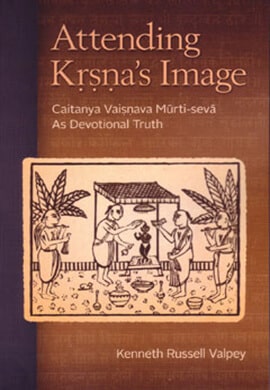There is a steady and growing scholarly and popular interest in Hindu religious – especially devotional (bhakti) traditions as forms of spiritual practice and expressions of divine embodiment. Associated with this is the attention to sacred images and their worship. This book extends the discussion on Indian images and their worship, bringing historical and comparative dimensions and considering Krishna worship in the context of modernity, both in India and the West. It focuses on one specific worship tradition, the Chaitanya Vaishnava tradition, emerging in sixteenth-century northern and eastern India and now expanded to countries worldwide as a result of missionary Hinduism reaching both the Hindu diaspora and Western seekers.
Situating current practice in historical contexts, the author keeps central the interrelationship of text and image as both migrated westward in the late twentieth century and take firm root today. By focusing on two temples and their Krishna images (murtis) – one in the north Indian pilgrimage town of Vrindavan, the other Bhaktivedanta Manor just outside London – this study brings forth a nuanced picture of a complex and ever-changing tradition of devotional practice (seva) and the theological reflection supporting it.
By applying the comparative category of ‘religious truth’, the author provides a comprehensive understanding of a living religious tradition. He successfully demonstrates the understanding of devotion as a process of participation with divine embodiment in which worship of Krishna’s image is integral. This book spans several disciplines – theology, anthropology, art history, and philosophy – to provide a valuable contribution to the understanding of contemporary Hindu temple culture.
Reasons to read Attending Krsna’s Image
For pujaris and aspiring pujaris:
- Get a deeper understanding of the logic of deity worship, and the rich tradition behind our practice.
- Get a better understanding of how rules relate to devotional emotions in the context of deity worship.
- Become better equipped to explain deity worship to interested persons.
- See how our practice of deity worship is supported by a web of scriptures, and how we relate practice to scriptural injunctions.
- Find out details of just how Radharamana is worshiped (as Prabhupada desired pujaris to know)
For devotee householders:
- Get the big picture of our Vaishnava culture as centred in the worship of Krishna.
- Become inspired to give a more prominent place to deity worship in you and your family’s lives.
For temple and other project managers and leaders of congregations:
- See more clearly what the aim of deity worship is in relationship to the entirety of your project.
- Understand more clearly what are the inherent challenges of maintaining an ongoing deity worship program.
- Get ideas how to develop deity worship to attract more people to take part in the project.
